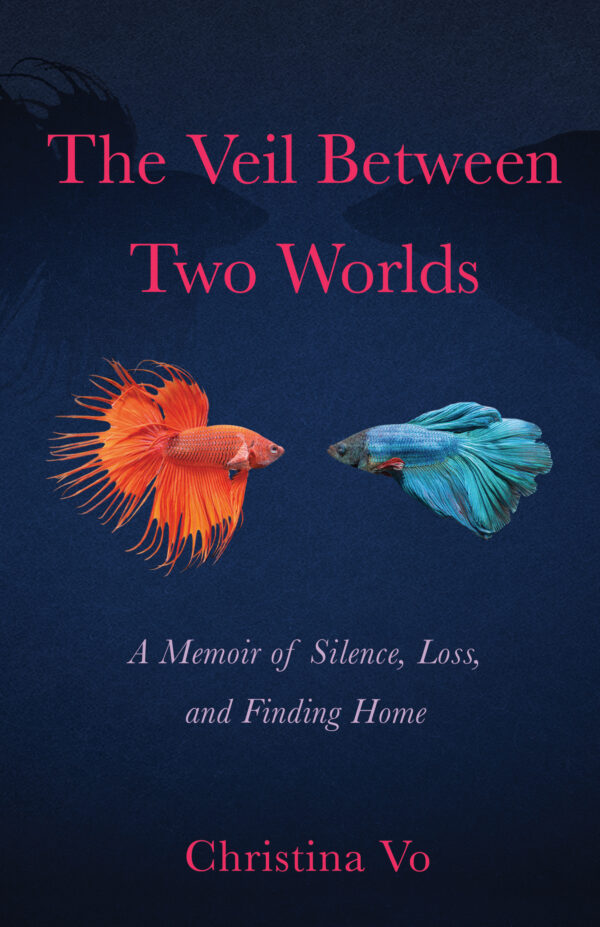The Veil Between Two Worlds: A Memoir of Silence, Loss, and Finding Home
Written by Christina Vo
April 25, 2023
224 pp.
ISBN: 978-1-64742-397-1
I must admit that I had very little knowledge of ayahuasca prior to reading Vietnamese American writer Christina Vo’s The Veil Between Two Worlds: A Memoir of Silence, Loss, and Finding Home. I had always imagined waifish sage-burning women in flowy dresses in an overcrowded desert music festival, so I didn’t really know what “doing” ayahuasca was.
Vo’s memoir provided a clearer glimpse of how many people in the modern world engage with this Indigenous South American plant medicine with an intention to heal, as opposed to as a trendy form of recreation. I was pleasantly surprised to learn that there are Asian Americans who are embracing ayahuasca as a part of their paths to growth. The primary catalysts that drive Vo’s journey in this memoir are turning forty and her processing of her mother’s passing from cancer when she was a teen.
A self-described “restless soul,” she has lived all over—as a child in places such as Connecticut, Utah, and Indiana, and as an adult, in Vietnam, the U.K., and San Francisco. Her wayfaring nature leads her to spiritual communities in the U.S. Southwest like Ojai, Santa Barbara, and Santa Fe. Though she seems to seek mother figures and meaningful relationships with women throughout, she often experiences particularly tense relationships with other women during her time spent in these areas. For example, in Ojai, Vo is coached and advised by Siobhan, an at times volatile woman; Vo recognizes that she is seeking her mother in both Siobhan’s comforting decisiveness and her flashes of anger. At an ayahuasca ceremony near Santa Barbara, Vo struggles with a woman shaman’s criticism of her unintentional exclusion of transgender experiences and is so overwhelmed by her desire for comforting “maternal love” that she has trouble engaging in accountability.
Vo also writes intimately about other important relationships, including with her sister, who struggles with drug addiction, as well as with her emotionally absent father, her roommates, and her romantic partners. Perhaps subconsciously, she writes herself as struggling with her own maternality. She describes how with others she “wanted to be the savior, even if I hadn’t been asked. . . I became a problem-solver and coordinator, the person upon whom others relied to get things done. While I resented this role, that’s also where I felt most comfortable.” This struggle may be familiar to some readers who feel pressured to take on too many responsibilities at the expense of their own well-being.
Vo is first introduced to ayahuasca by her close friend David, a fellow Vietnamese American who is part of a Bay Area ayahuasca community that was “formed specifically for people of color and those racialized as white who were working to unravel how systemic racism and being a person of color affected their lives.” She becomes very engaged during her first ayahuasca ritual with this community. She describes an energy, which she later experiences as female, embodied by a “powerful white light that filled the room” and “changed shape and form: the voice of the energy turned calm and soothing, and more powerful than anything I’d ever experienced.” While her writings on ayahuasca exhibit a well-intentioned curiosity and respect for the plant medicine, she seems primarily drawn to its novelty. From my outsider’s perspective, it is difficult to ascertain the authenticity of most of the ceremonies described, as they appeared to be led by non-indigenous practitioners, which makes me question whether they are cultural appropriation or cultural appreciation. Nonetheless, I view such engagement with spiritual practices as a continuation of the trend of younger generations of Asian Americans seeking ways to prioritize their mental health.
Vo also explores Đám Giổ, a Vietnamese death anniversary celebration “which is not a sorrowful occasion but rather a festive time for family members to reunite and celebrate the lives of those who have passed.” Vo honors her mother by celebrating her Đám Giổ for the first time, on the twenty-fourth anniversary of her passing. Not unlike her experience during her inaugural ayahuasca ceremony, she “felt a potent energy in the living room—dense, as if the spirit of my mother and whichever spirits she’d brought with her had entered.”
Often reminiscent of catching up with a close friend in need of a sounding board or confidant, Vo’s prose is quite accessible and candid. Her wanderlust on top of her nomadic childhood adds to a general sense of her untetheredness in the world as someone who “didn’t entirely understand what feeling ‘at home’ meant.” This may be relatable to readers who have often found themselves feeling disconnected from their environment. Vo also explores the familiar themes of intergenerational trauma and parents whose love languages differ from their children’s; brief mentions of the coronavirus pandemic root the memoir in the modern era. Her story is especially ideal for those who are curious about ayahuasca practice from the positionality of an Asian American person, and for those who are seeking to learn about spiritual ways of processing grief.
Review by Amanda Cheung, editing assistance by Anastasia Chiu.
Book reviews and author interviews featured on APALAweb.org are reflective of the reviewer and interviewer only and are conducted separately from and independently of APALA and the APALA Literature Awards Committee and juries.

